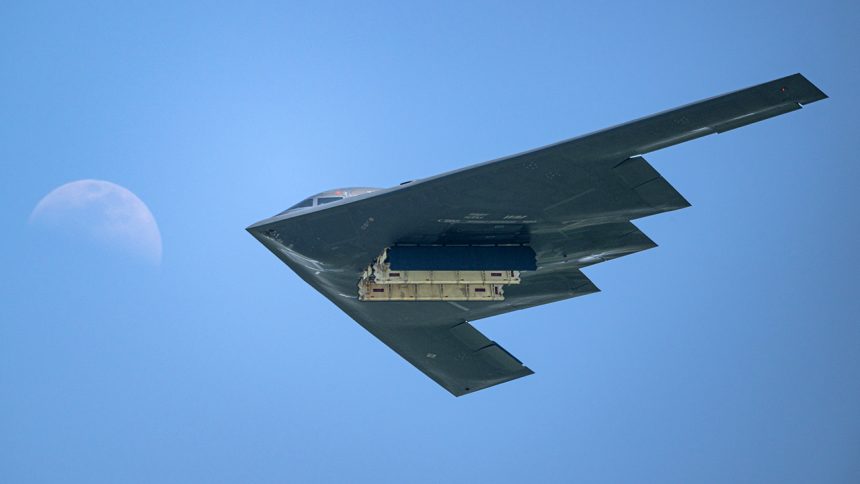We discussed about the B-2 and the U.S. Air Force’s nuclear bomber fleet with the newly appointed 393rd Bomb Squadron Commander, Lt. Colonel Joseph “Zorro” Manglitz. With experience in the B-2 and B-52 he describes himself as “your quintessential nuclear bomber pilot”.
It has been five years since Whiteman Air Force Base, Missouri, has hosted an airshow, and given the unique and unrivalled lineup that graced the skies July 13 and 14, 2024, this show was well worth the wait.
The first inkling that special aircraft formations might be on tap for the show came after a brief talk with 509th Bomb Wing and base commander, Colonel Keith Butler. Col. Butler coyly intimated that there might be some special surprises in the show.
Due to the fact that Whiteman AFB is the sole base to house the B-2 Spirit bomber, possibilities started running wild as to who might be joining up with the B-2 during the airshow.
Could it be the B-29 Superfortress, “Doc” who was on the list of solo flying acts for the air show. Well, as it turned out, the answer was a resounding “yes”.
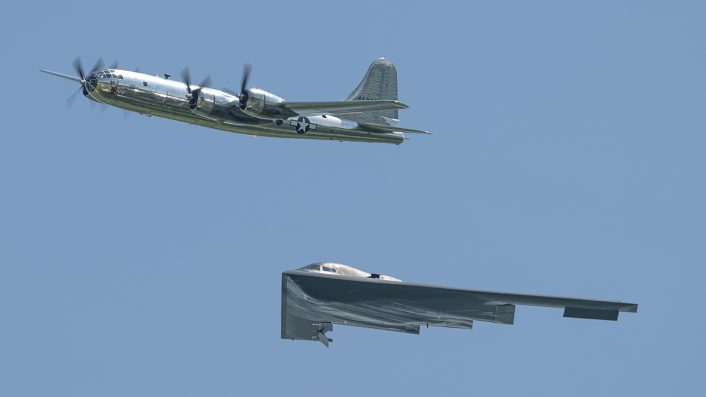
The B-2 not only flew with the B-29, but also with two T-38 Talon jet trainers, from Whiteman AFB, making the 2024 Wings Over Whiteman Airshow, certainly one of the most memorable airshows in recent memory.
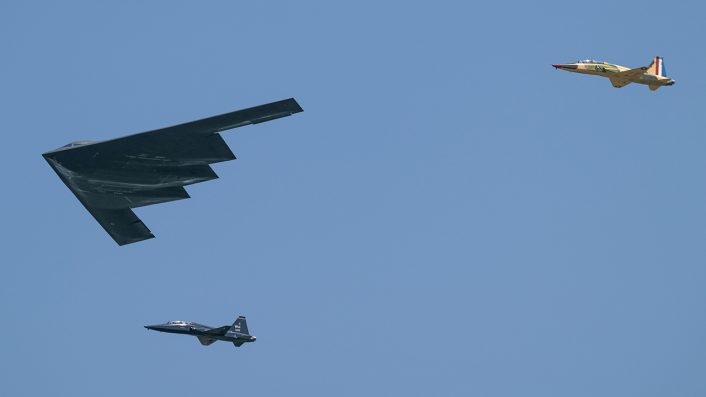
Along with the surprising and much savored formation flights, the crowd were truly awed by the solo flybys of the Whiteman Air Force Base, Northrop B-2 Spirit bomber, from the 393rd Bomb Squadron.
We at The Aviationist were privileged to have the opportunity to interview the newly appointed, 393rd Bomb Squadron commander from Whiteman Air Force Base, Lt. Colonel Joseph “Zorro” Manglitz.
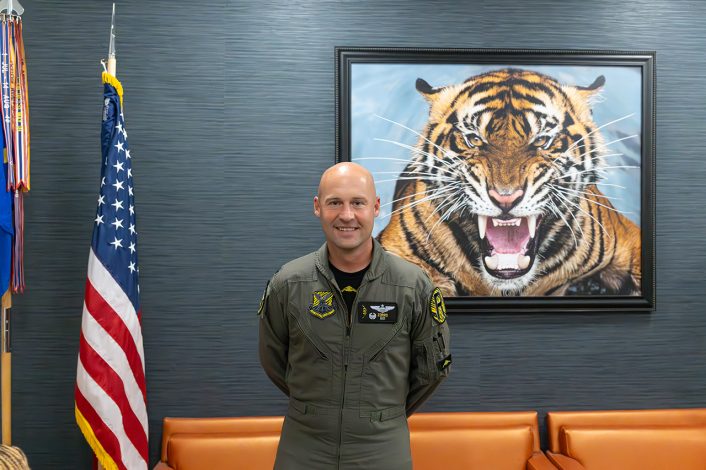
The Aviationist: Please tell us a little bit about yourself. Where are you from, where did you go to school, and how did you become a B-2 pilot. What aircraft did you fly prior to the B-2 and how many hours do you have in the B-2?
Zorro: I’m a Nebraskan, from Lincoln, Nebraska. I wasn’t born there, but raised there. Went to the University of Nebraska, Lincoln, did ROTC there. I had an interesting background in that I was a music education major. At Nebraska, my initial intent was to do military bands, because that is what I did growing up. Then halfway through ROTC, is when you test and get racked and stacked for a pilot slot, and I got awarded that, thus I knew, I couldn’t turn that down. So, I set my eyes on that path and didn’t turn back. Graduated, and went to pilot training at Enid, Oklahoma, Vance Air Force Base.
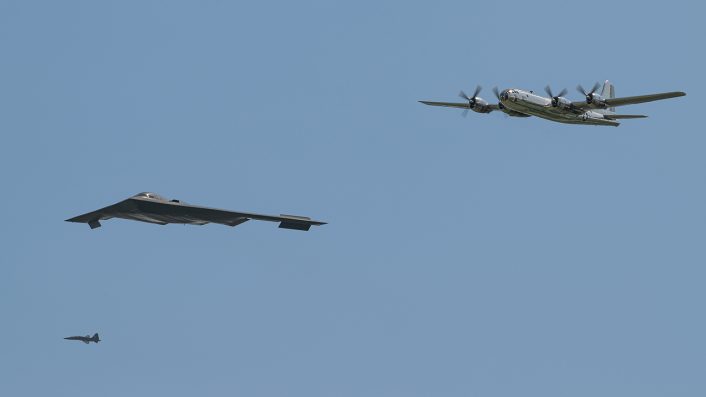
From there, I knew I wanted to be a bomber pilot; thus, I created my “dream sheet”, and based on what’s available at the time they give you that. I started off as a B-52 pilot. Mostly at Minot Air Force Base. I was there for about four years, left as an instructor pilot. At that time in our community, you had to apply to Whiteman AFB for the B-2, and interview here, as well as perform a simulator evaluation. Thankfully, I was selected.
I arrived at Whiteman in 2014 and started my B-2 upgrades. Left Whiteman in 2019 as an Instructor Evaluator Pilot. Then went to Command and General Staff College for a year, then did a two-year staff at USSTRATCOM in Omaha. After Omaha, I came back to Whiteman, as Wing Inspector General for a year, then second in command of the schoolhouse for a year. I’ve been Squadron Commander of the 393rd for a month.
I am your quintessential nuclear bomber pilot. I own both of the nuclear bombers in the inventory. That’s kind of my bread and butter background.
As far as hours I have a little over 1,000 in the B-52, and about 700 or so, here, in the B-2. Total flying hours is about 2,000.
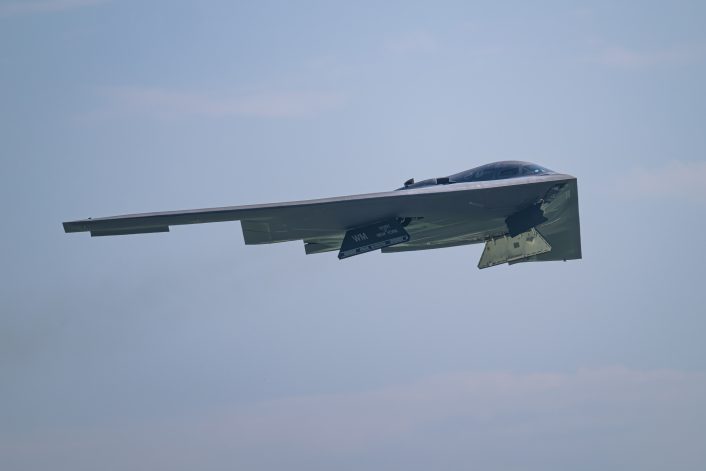
How do you maintain your proficiency and flight readiness for B-2 missions?
We have a standard that we have to fly to each month, and we call it Combat Mission Ready. We expect our B-2 pilots to fly at least twice a month, two sorties in the B-2, as well as three flights in the T-38, and then at least two simulator missions in the B-2 and then obviously be current on all your ground training. So that’s how we assess the metrics of readiness, is making sure everybody gets those beans, if you will.
The readiness then goes deeper to that, and this is my viewpoint as a commander. How ready are we to meet all of our tasking that we have for the unit, whether that be nuclear or conventional, and then, the core competencies that contribute to mission success, mission readiness. We then tailor those events to the specific needs of the pilot and where they’re at in their progression.
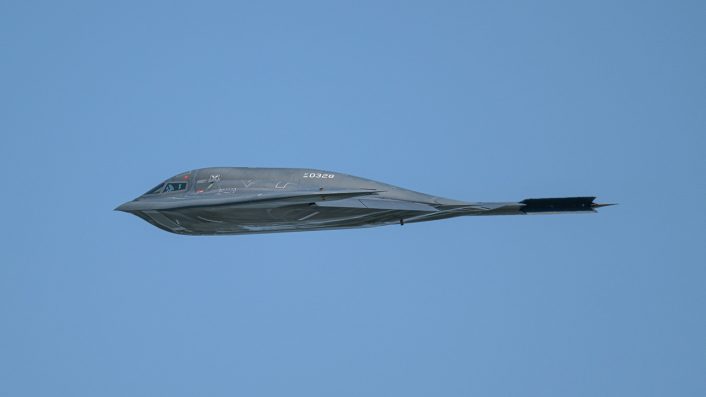
Does this apply to everyone in the squadron, that being from the most junior pilot to the most experienced, in the 393rd?
Yes, Whiteman has on the active-duty side, three operational squadrons. One is the Operational Support Squadron, and then you have two flying squadrons. One is the school house that I was the Director of Operations for building those pilots. As soon as they graduate, they come over here, this is our combat squadron.
Can you please describe what it is like to fly the B-2, and compare and contrast it with the B-52?
Starting with the compare and contrast, I think the biggest difference is the crew composition between the two aircraft. The primary crew on the B-52, when I was flying it, was five. My understanding is they’re going to four, I don’t know where that is in the process.
In the B-52 you’re operating in very independent but complementary roles on the jet, operating as a crew of two pilots, two navigators and electronic warfare officers.
Here in the B-2, the biggest difference is two pilots. They are both pilots. But they do also have, again, individual but complementary roles in it. The left seats, the pilot, the right seats, the mission commander. Generically speaking, the pilot is focused on really flying the aircraft, getting it to the right place at the right time with the right fuel etc. On the right side, you’re focused on the mission aspects of that. That being the weapons employment, the survivability and defense of the jet, those type of things. Both are qualified in both positions, the other biggest aspect of it is longer duration missions. You can’t augment crews. We just have the two pilots that have to manage that endurance of the long duration mission.
Clearly another difference is the stealth nature of our aircraft, and how we employ it, that’s really the biggest difference. On the B-52 side, you have the same similar payloads. There are differences, but same range capability as well, in terms of air refueling, but our side, (the B-2), is the penetrating bomber.
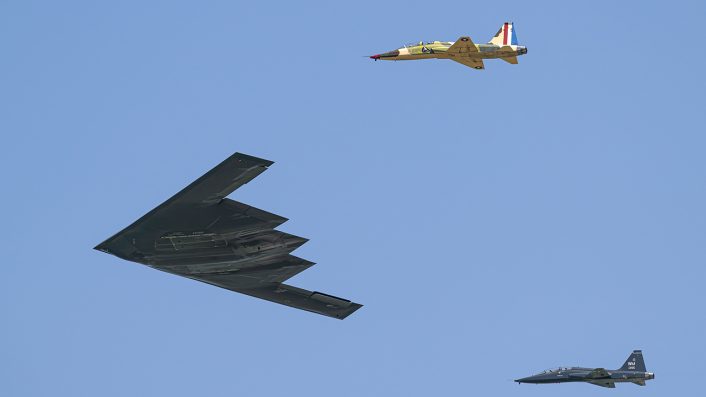
I would say some of the flight characteristics are generally similar in terms of the speed, altitude employments, things of that nature, I would say the B-2 is more responsive. I kind of say, jokingly, it flies like a Cadillac, it’s very smooth. Anytime we bring folks up in the jet that have not flown it, such as a student for the first time, as soon as you move that stick, the jet responds.
On the B-52 side, you move the yoke and it’s approximately a second later, then the jet kind of reacts. The B-52, it’s a beast to fly, right, and that’s why it’s an awesome aircraft.
Is there any truth to the claim that the B-2 flies like a fighter?
Yes, I agree, the cockpit is set up like that. We each have the throttles over on the left side, stick in the middle. The two sides of the cockpit are essentially mirrored and the same, therefore, if we’re flying together and you’re out of the seat taking a nap because of crew fatigue, I can operate the aircraft just fine. The only difference is the there are some switch differences for startup and shutdown.
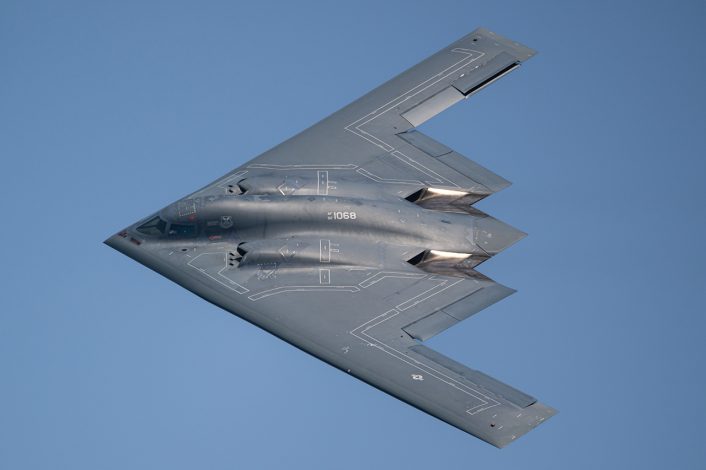
Can you talk about some of the operational missions that you have flown?
Operational missions that I have flown myself and that we fly somewhat regularly, can be categorized as belonging in the deterrence realm; we call them bomber task force missions. Where we take jets from the central United States and go to an area of operation that is strategic and important in the world. So that may be Guam, that may be Diego Garcia, Fairford in the UK, or Australia. These types of places that are obviously significant. Typically, we’re there for about a month at a time. A whole squadron will deploy, with maintenance, security forces and comm. support, operating there as an expeditionary bomb squadron. This gives us an opportunity to interact with our allied partners in that area of responsibility.
Those are the most rewarding because we’re out there training with our allied partners, doing a lot of the things that we do here at home station, but we’re able to really refine those tactics, techniques, procedures.
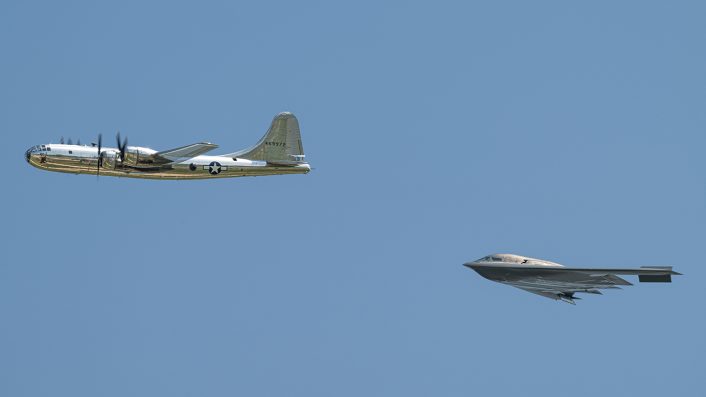
On the combat side of things, the one mission that I had participated on, was as a planner for our 2017 Libya strike, that we executed. That was a very rewarding experience, as a combat pilot, just seeing how in a pretty short time frame we got the tasking, and everybody was involved in getting those jets loaded with 80 GBU-38’s, to launch from here, fly over 30 hours back and forth to Libya, and eliminate some ISIS fighters over there.
These were non-stop flights, two air refuelings there, one post flight and then two on the way back.
Can you please describe a particularly memorable mission or experience while flying the B-2?
As an instructor in an aircraft, what’s always memorable and rewarding is when you see a student start to progress in their abilities. That’s the future of our force. Our most difficult core competency as a pilot in this aircraft is air refueling. It takes a student usually several repetitions to get that. It’s also a training event that doesn’t necessarily happen every flight because we have to coordinate with an air refueling unit, have the right time and duration to make that happen. The weather has to be good as well. But when you do fly with a student and you teach them some of your techniques and how to think and then see it click in their mind. For instance, there was a student that I flew with recently, and they were having some difficulties and they were getting close to their check ride, we spent nearly an hour air refueling behind a KC-135.
Yes, and I have spoken to many KC-135 pilots and they mention that refueling a B-2 is one of their most memorable missions.
It’s a stressful one for them because they don’t want to do a boom strike on the low-observable coatings.
What are the most challenging aspects of flying the B-2?
In terms of stick and rudder pilot skills, it’s the air refueling, but overall, the most challenging part about flying the B-2 is the employment of the weapon system. It’s a very complicated aircraft, and with the advancements in technology, we’re just adding on complexity to how we employ it with different communication systems, different defense systems, those type of things. Therefore, it takes a lot for our younger pilots, as they grow to learn how to coordinate and prioritize those tasks, in the mission employment.
What changes and advancements do you foresee in the role and mission of the B-2 in the coming years? What is the projected timeline for the B-2.
Honestly, I think we are just continuing to hone a lot of the same skills, taskings, capabilities, that we have right now. This aircraft has now gone over the thirty year mark, therefore, I think we, as an enterprise, are continuing to learn, and even in just my time employing this aircraft, have learned how to better employ this aircraft, and what we really need with the modern day threats that are out there. Also, we get better, and our roles will kind of advance, with how we integrate with our Combat Air Force Partners, as well as our Allied Partners. The most important thing with that, and I know you’re probably going to ask about the B-21, is that I’m focused on, (as the operational commander here), is that this aircraft has to stay ready and capable now, and all the way to the point that the B-21 is fully operational. The timeline is ever changing, as they evaluate the current strategic environment. What I like to shift back to is my timeline is very clear, I am on the hook right now.

In my time at USSTRATCOM, I worked in the Capabilities and Requirements division. We worked on programs like the B-21, like the LRSO, the Long Range Stand Off Weapon, B-52 modernization. The biggest thing that I learned, and it was a point that our leadership made very clear, is that the we need to focus on the sustainment of the B-2, until the B-21 is fully operational. At times people were looking at initial operation capability, (IOC), nowadays, our leadership is stating, it is full operational capability, which is a way off in terms of my perspective.
Yes, therefore, you just think about this squadron, what your people have to do day in day out, you’ll let the other variables work themselves out, as far as progress on the B-21
Correct, I will say, we have sent some of my peers, a Lt. Colonel, he is a test squadron commander right now on the B-21 at Edwards. Thus, we have given some of our B-2 talent over to that program. Which makes a lot of sense, in that this is where stealth bomber employment was really honed. thus, they’ve taken that knowledge and are standing that up, as well as, and it’s very clear to me, that some of my younger pilots in the squadron will certainly have the opportunity to go over to the B-21 at some point in their career.
Any final thoughts you would like to punctuate?
I think we touched on this briefly a bit in terms of what I think is really important. We really level a lot of responsibility and expectation on our B-2 pilots. They are dual qualified conventional and nuclear bomber pilots, and the number one mission is the nuclear mission, therefore, we have to focus on that. We exercise to that. But, at the same time, they also need to be progressing in their abilities on the conventional side, and that’s a lot to manage, the B-52 is the same. But otherwise, it’s fairly unique. Also, on our B-2 pilots we expect them, and they are, dual qualified in two different aircraft, the B-2 and the T-38. The T-38s are our companion trainer program. I am a huge advocate of that program. I see the value in it, for our pilots. I mentioned that they have to fly twice a month. Instructors, generally, are flying more than that, but then those T-38 sorties ensure that they have their stick and rudder skills sharp.
A lot of people ask me, what is that value of your pilots flying the T-38 when it’s so different from the B-2? I say, that’s truly the value, that it’s almost polar opposite. We get to do aerobatics; we get to take it off station, test our knowledge of flying different instrument approaches. The orientation of the aircraft is different, close formation, those type of things, they keep our pilots sharp.
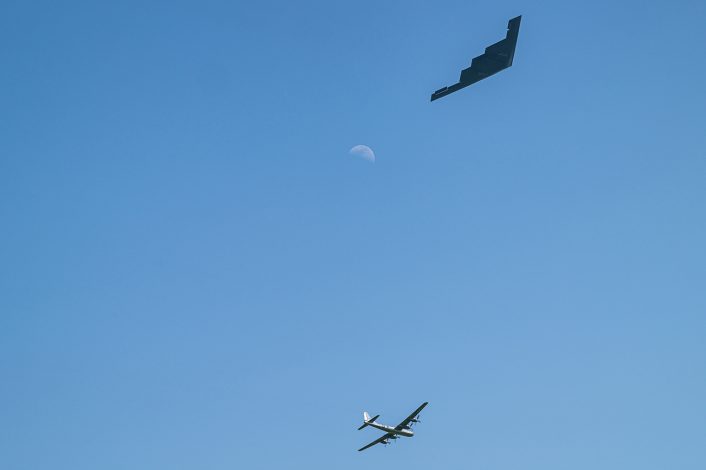
The Aviationist would like to send out huge thanks to TSgt. Dylan Nuckolls and all the fine folks at the 509th Bomb Wing Public Affairs as well as the 393rd Bomb Squadron Public Affairs.
In addition, a very special thanks to Lt. Col. Joseph “Zorro” Manglitz of the 393rd Bomb Squadron, for his professionalism as well as patience while walking me through the interview. Many, many thanks.

